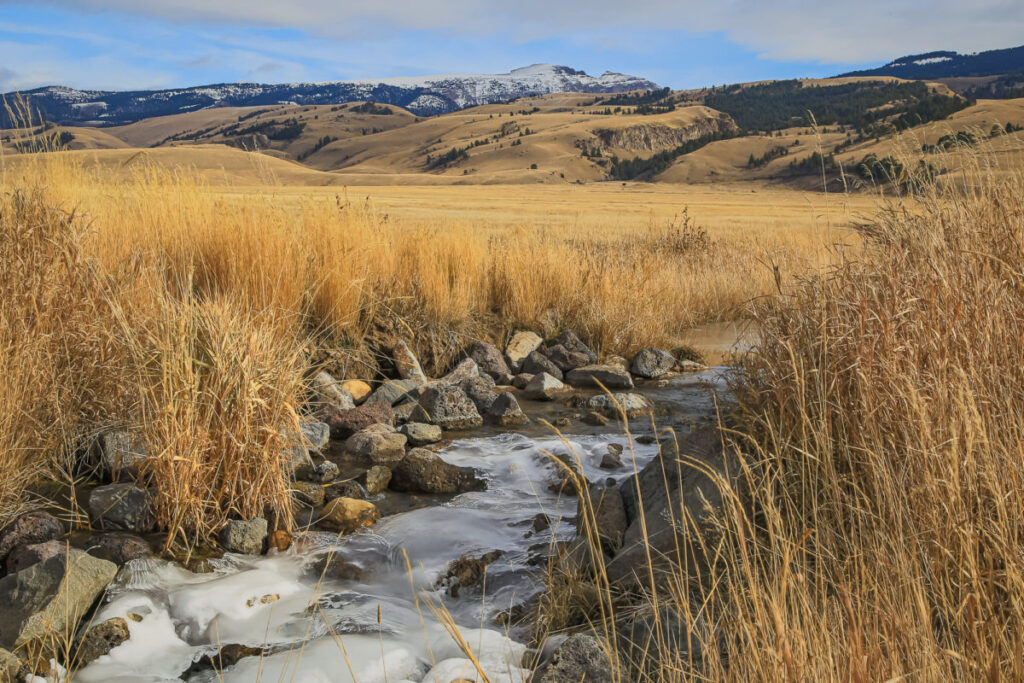I often think about how a shallow or absent snowpack affects the animals of the Greater Yellowstone Ecosystem. This year it has been an unusually warm November and December, so far. There have been several snowstorms, but with most days on the Jackson Hole valley floor well above freezing, each snow accumulation has melted. In the Tetons and the other surrounding mountain ranges, colder temperatures at the higher elevations allow retention of the snowpack. In this weather pattern, some animals benefit and some don’t.
Although at first, it sounds counterintuitive, the air space in the snow is a great insulator. Two or more feet of snow on the ground can insulate the ground, holding in the geothermal heat, keeping the soil surface right around 32 degrees Fahrenheit while the air temperature above the snowpack can be 10 degrees below zero or colder. Insects hibernating on the ground amongst the leaf and vegetation litter depend on those insulating properties of snow to protect them from the cold. Although Uinta ground squirrels have been in their hibernation dens below the frost line since late July and August, they have to be wondering why cold air keeps sinking into their uncovered holes. Ruffed grouse and dusky grouse will normally dig themselves down into homemade snow caves a foot or more below the snow’s surface to prevent them from losing too much body heat, without the snow depth they likely endure bitter winter nights. White-footed mice foraging by the cover of darkness are missing the snowpack that protects them from chilly temperatures and from the sight of predators such as owls, foxes, and coyotes.
Consider also those few animal species who shed their brown or gray summer coats as they develop white-colored winter fur. This change in fur tends to be triggered by daylight periods getting shorter in the Fall. On years like this when the snowpack is slow to accumulate, there are short-tailed weasels, long-tailed weasels, and snowshoe hares that have white-colored coats and no snow to hide in. Allowing their predators an advantage, as the white-colored coats that are meant to help camouflage the animals, actually make them easier to see. Mismatched coats have a mortality cost for some animals, leading to a bounty for their predators.

The lack of snow cover allows some opportunistic animals additional sources of food as well as the conservation of strength. It seems as though grizzly bears may benefit from not having to walk through deep snow, saving energy while making last-minute accumulations of calories before going into hibernation. Additionally, grizzlies can benefit this time of year from finding leftover carcasses of prey killed by wolves or mountain lions, or discarded gut piles left by human hunters. Bison have easy access to grass right now without having to use their snowplow-like heads to move snow aside to get to the food. Elk, mule deer, and bighorn sheep don’t have to use their front hooves to scrape snow aside to forage. Moose have no problem finding plenty of bitterbrush, one of their favorite foods, when snow is shallow and air temperatures are cool enough to allow them to forage in the open without risk of heat stress. Supplemental calories without the additional expenditure of energy is a luxury for these animals in what is often the most unforgiving season.

I wonder if there are a few pronghorn antelope who have decided at the last minute to try to make a run along the Path of the Pronghorn down to the Red Desert of southwestern Wyoming. In a normal year at this point they would be stuck in the valley, due to the snow, to eke out a living.
These are the kinds of things that Naturalists fall asleep at night thinking about.
-Kevin Taylor
Want to be the first to know what Kevin notices next? Or when new wildlife tours are launching? Sign up for our Wildlife Expeditions newsletter, Fresh Tracks, to receive the latest wildlife news, exclusive tour discounts, and more!


